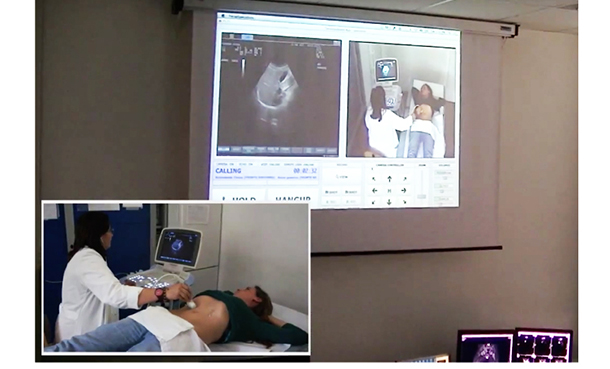Benefits of remote radiologist-mentored emergency tele-ultrasound exams
The combination of pediatricians working in hospital emergency departments and radiologists providing counsel remotely can produce point-of-care ultrasound examinations that produce accurate and timely diagnoses, according to a small Italian study published in PLoS One.

Image courtesy of M. Lazzerini, MD, Institute for Maternal and Child Health IRCCS Burlo Garofolo.
Emergency physicians are increasingly performing and independently interpreting point-of-care ultrasound exams. Radiologists have interpreted ultrasound exams using teleradiology for decades. What is unique about this study is that remotely located pediatric radiologists tele-mentored pediatricians working in the ED of a third level pediatric teaching hospital, the Institute for Maternal and Child Health IRCCS Burlo Garofolo in Trieste, Italy. The study was conducted to evaluate the diagnostic accuracy of point-of-care emergency ultrasound exams performed in this scenario compared to ultrasound exams performed in a radiology department and formally interpreted by a radiologist.
With the advent of point-of-care ultrasound, its increasing use by non-radiologists has generated controversy relating to accuracy of the exam and diagnosis from the images. Because it is unclear how many children who have this type of exam subsequently have a comprehensive examination performed and interpreted by a radiologist, the authors initiated a study to determine if a point-of-care ultrasound exam with guidance from a radiologist would be of high diagnostic quality and not require subsequent ultrasound imaging.
The prospective study analyzed 170 point-of-care ultrasound exams of 52 children presenting at the hospital emergency department with a predefined set of clinical scenarios. These included traumatic and/or unspecified abdominal pain, suspected appendicitis, suspected intussusceptions, suspected pulmonary infection, acute hip pain, soft tissue swelling after trauma, and suspected hypertrophic pyloric stenosis. The study included four pediatricians and five pediatric radiologists.
Each study participant had three consecutive ultrasound examinations. The first was performed by a pediatrician who was guided remotely via tele-ultrasound by a senior pediatric radiologist, a process that took a median of less than 7 minutes. The second exam was performed by the radiologist who provided remote guidance, and the third exam was performed by another, independent radiologist. In each scenario, 15 cases were positively diagnosed. Of the 155 cases that the pediatrician diagnosed as negative, the mentoring radiologist identified one positive case and the independent radiologist identified two positive cases (the accurate diagnosis). The authors point out that among the two false negatives in the hands of pediatricians, one was a minimal per-hepatic effusion, while the other was an intussusception that may not have been present when the series of ultrasound exams began.
Principal investigator Floriana Zennaro, MD, senior radiologist, and colleagues compared the diagnoses of the pediatrician performing the study with the diagnoses of the radiologist providing guidance as well as the diagnoses of the two radiologists. They evaluated the reasons for the differences between the two radiologists. They also analyzed the time required to perform the tele-ultrasound exam, the incidences of technical difficulties, and the quality of the video/audio transmission of the tele-ultrasound.
>
Low-cost, commercial off-the-shelf equipment was used to transmit the ultrasound images and a video of the pediatrician performing the exam to the remote radiologist. Only two technical difficulties occurred, and more than 75% of the images were rated as being of very good to excellent quality.
The study shows the promise of radiologist-assisted, point-of-care ultrasound exams that are performed by non-radiologists as providing immediate accurate diagnostic information and as offering great potential cost savings. This also could more efficiently utilize the expertise of pediatric radiologists by making them accessible through just-in-time tele-mentoring to multiple healthcare facilities.
The authors recommend that future studies evaluate the overall benefit and cost savings of using tele-ultrasound in this manner, with more children enrolled presenting with more diversified clinical scenarios. Co-author pediatrician Marzia Lazzerini, PhD, told Applied Radiology that the research team was planning to perform additional studies, exploring how low cost technologies can help the work of physicians.
REFERENCE
- Zennaro F, Neri E, Nappi F, et al. Real-Time Tele-Mentored Low Cost “Point of Care US” in the Hands of Paediatricians in the Emergency Department: Diagnostic Accuracy Compared to Expert Radiologists. PLoS One. 2016 11;10:e0164539. DOI:10.1371/journal.pone.0164539.
